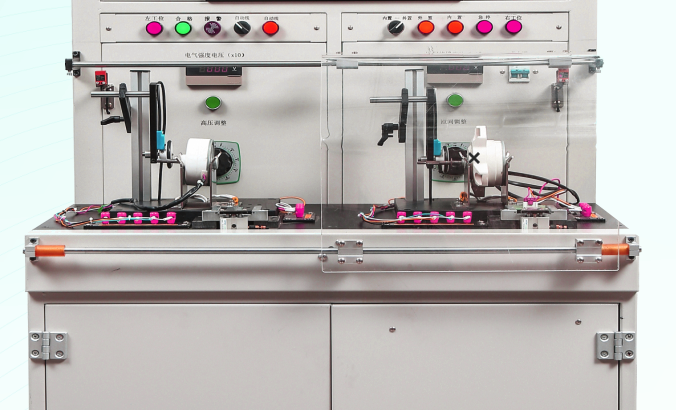What are the common sensor failures and their solutions for brushless motor motor automatic no load tester?
The common sensor failures and their solutions for brushless motor motor automatic no-load tester are as follows:
1、Rotational speed sensor failure
Failure phenomenon
The motor speed displayed by the tester is abnormal and does not match with the actual speed, or the speed display is unstable, with jumps and fluctuations.
The actual speed of the motor is normal, but the test system cannot accurately measure and display the speed, resulting in the inability to carry out normal speed-related tests.
Cause Analysis
The RPM sensor probe is dirty, with impurities such as dust or metal shavings adhering to it, affecting signal acquisition.
The sensor is improperly installed, and the gap between it and the motor shaft is too large or too small, resulting in unstable signal transmission.
The sensor itself is damaged, such as internal electronic component failure, line break or short circuit.
Electromagnetic interference affects the transmission of the sensor signal, and there is a strong electromagnetic field source nearby.
Solution
Clean the speed sensor probe regularly, use a clean cloth or special cleaner to remove impurities.
Re-adjust the sensor mounting position, and make sure that the clearance between the sensor and the motor shaft is appropriate according to the equipment manual.
Replace the damaged speed sensor and choose a model that matches the test machine.
Take shielding measures for the sensor's signal line, such as the use of shielded wire, and the shielding layer is reliably grounded, away from strong electromagnetic field sources.

2、Temperature sensor failure
Failure phenomenon
During the test, the temperature display value is obviously abnormal, too high or too low, and the actual motor temperature difference is large.
The temperature sensor is unable to accurately monitor the motor temperature in real time, resulting in the tester not being able to trigger overheating protection and other functions in a timely manner.
Cause analysis
The temperature sensor probe has poor contact with the motor surface, there is a gap or contact is not tight, resulting in inaccurate temperature measurement.
Aging of the sensor, performance degradation, reduced measurement accuracy.
The connecting wire of the temperature sensor is loose, broken or short-circuited, affecting the signal transmission.
The test environment temperature is too high or too low, beyond the normal operating range of the temperature sensor.
Solution
Check the contact between the temperature sensor probe and the motor to ensure a tight fit, which can be fixed with heat-conducting adhesive or fixing fixture.
Replace the aging temperature sensor, choose the product with high precision and good stability.
Check and repair the connection line of the temperature sensor, make sure the connection is firm, no broken or short circuit.
Improve the test environment, the test machine placed in a suitable temperature environment, if necessary, for the temperature sensor to install thermal insulation or heat dissipation devices.
3、Current sensor failure
Failure phenomenon
The motor no-load current displayed by the tester is abnormal, with a large deviation from the theoretical value, or the current display fluctuates violently.
It is impossible to accurately measure the current consumption of the motor during no-load operation, which affects the evaluation of motor performance.
Cause analysis
The range of the current sensor is improperly selected, and the range is too large or too small for the current value being tested, resulting in inaccurate measurement.
Damage to the electronic components inside the sensor, such as deterioration of the sampling resistor, failure of the amplifier, etc.
Incorrect installation position of the current sensor, which affects the accuracy of current measurement.
The power supply voltage is unstable, affecting the normal operation of the current sensor.
Solution
According to the rated current of the motor and test requirements, choose the range of the current sensor reasonably.
Overhaul the current sensor or replace the damaged electronic components, or replace the whole sensor if it cannot be repaired.
Reinstall the current sensor according to the correct installation method and position requirements.
Check the power supply system of the test machine to ensure that the power supply voltage is stable, if necessary, install a voltage regulator.
4, position sensor failure
Failure phenomenon
When the motor is running at no load, the position sensor is unable to accurately detect the position of the motor rotor, resulting in motor starting difficulties or unstable operation.
The tester is unable to carry out correct control and testing according to the motor rotor position, resulting in abnormal stoppage or false alarm.
Cause Analysis
The installation precision of the position sensor is insufficient, resulting in an excessive deviation in the relative position between it and the motor rotor.
The magnetic element of the sensor is demagnetized or damaged, affecting the detection of the position signal.
Failure of the signal processing circuit of the position sensor, such as damage to the filter capacitor and abnormal signal amplification circuit.
Solution
Re-adjust the installation position of the position sensor and use professional tools and instruments for accurate calibration.
Replace demagnetized or damaged magnetic components, or directly replace the position sensor.
Check the signal processing circuit of the position sensor and repair or replace the damaged electronic components.
※ If the above ways and means still can not solve the equipment failure, please contact the technical specialist of Xinhui Mechanical and Electrical Equipment Co.







